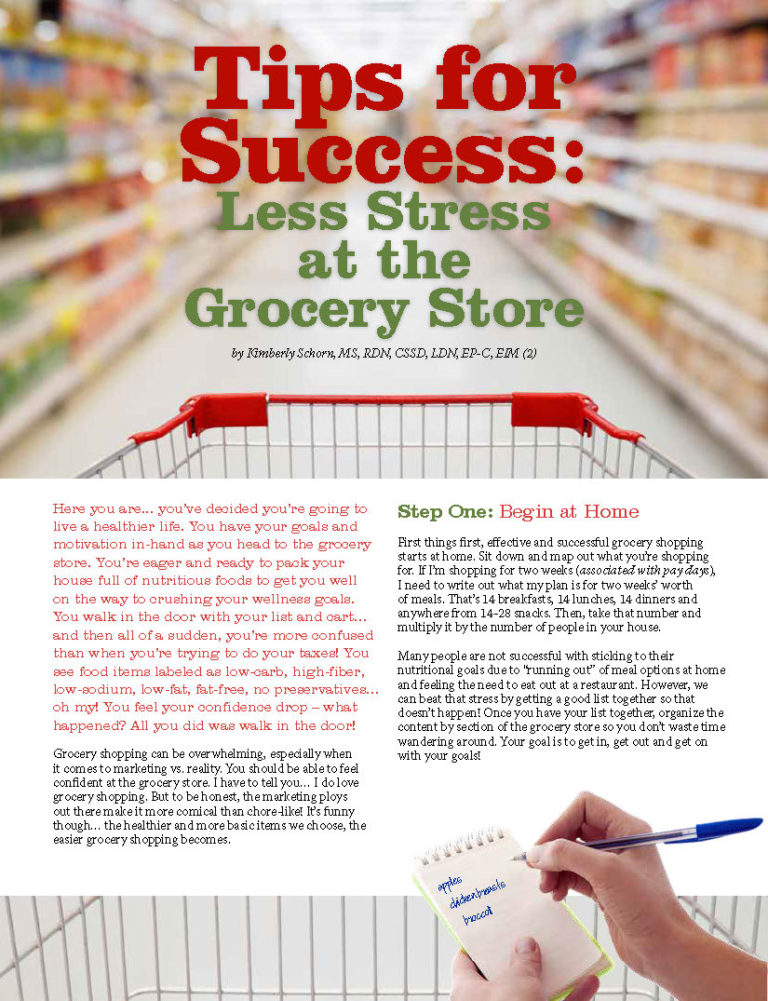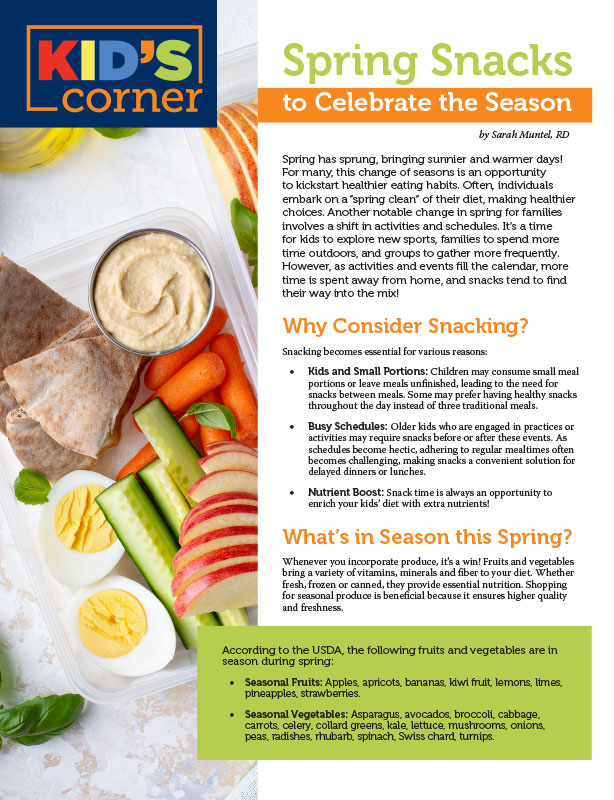Tips for Success: Less Stress at the Grocery Store


by Kimberly Schorn, MS, RDN, CSSD, LDN, EP-C, EIM (2)
Summer 2018
Here you are… you’ve decided you’re going to live a healthier life. You have your goals and motivation in-hand as you head to the grocery store. You’re eager and ready to pack your house full of nutritious foods to get you well on the way to crushing your wellness goals. You walk in the door with your list and cart… and then all of a sudden, you’re more confused than when you’re trying to do your taxes! You see food items labeled as low-carb, high-fiber, low-sodium, low-fat, fat-free, no preservatives… oh my! You feel your confidence drop – what happened? All you did was walk in the door!
Grocery shopping can be overwhelming, especially when it comes to marketing vs. reality. You should be able to feel confident at the grocery store. I have to tell you… I do love grocery shopping. But to be honest, the marketing ploys out there make it more comical than chore-like! It’s funny though… the healthier and more basic items we choose, the easier grocery shopping becomes.
Step One: Begin at Home
First things first, effective and successful grocery shopping starts at home. Sit down and map out what you’re shopping for. If I’m shopping for two weeks (associated with pay days), I need to write out what my plan is for two weeks’ worth of meals. That’s 14 breakfasts, 14 lunches, 14 dinners and anywhere from 14-28 snacks. Then, take that number and multiply it by the number of people in your house.
Many people are not successful with sticking to their nutritional goals due to “running out” of meal options at home and feeling the need to eat out at a restaurant. However, we can beat that stress by getting a good list together so that doesn’t happen! Once you have your list together, organize the content by section of the grocery store so you don’t waste time wandering around. Your goal is to get in, get out and get on with your goals!
Step Two: Consider Whole Foods – Starting with Produce
When it comes to living a healthy and fit life, you want to consume mostly whole foods. This means eating less from a box and choosing more whole fruits and veggies rather than juices and pre-packaged options. For example, consume more fresh fruits and snacks (like apples and peaches) rather than boxed juices or snack packs. Similarly, choose more fresh meats and dairy options rather than pre-packaged ravioli and “cheese-like” products.
Shopping the perimeter of your grocery store will get you in the right areas. Think about it for a moment – what’s along the walls of your grocery store? Typically, right when you walk in the door, you’re welcomed with the beauty of all colors of the season – with fresh fruits and vegetables! What an excellent place to start!
You should also be adventurous when shopping for fruits and veggies. Try something new – that’s how we find new foods we love and increase our vitamin, antioxidant and phytochemical intake! For example, many people think of oranges as a great source of Vitamin C. This is true, but did you know that bell peppers have more Vitamin C than oranges?
The same is true with many fruits and veggies, so venture out and try something different! Roasted fennel is amazing; whipped cauliflower and zucchini noodles are fantastic! And Brussels sprouts in your air fryer are almost magical. Don’t be afraid to get creative with your new healthy lifestyle. If you get frustrated with fresh foods going bad, just head to the freezer section. Choose veggies without sauces and fruits without added sugar and they will last for months!
Quick Tip: Choosing the Right Avocado
Most of the questions I receive are about avocados, so here’s some information to make sure you choose the right ones. When picking out an avocado, you want it to feel like a tennis ball. It should have a slight give but not be mushy.
However, if all your grocery store has is under-ripe avocadoes (green and really hard), that’s okay! Take them home and leave them on the counter until they have the slight tennis ball give. Once they do, place them in your refrigerator and you’ll be good to go!
Step Three: Grains and the Deli Section
Next in the grocery store, you’re greeted with fresh breads, deli items and natural cheeses. But for now, let’s talk grains. Whole grains are key! This beautiful bounty of fiber-rich food keeps us fuller during meal times to aid in weight-loss. Fiber-rich foods also help with managing diabetes, cholesterol and decreasing your risk for cancer.
An easy way to identify whether a whole grain is a good source of fiber is to look at the food label. First, always look at the serving size (one slice, etc.). Next, cruise on down to where the nutrition label says “fiber.” You’ll see grams, but you’ll also see a percentage. Use that percentage! If the number is five percent or less, that’s not a lot of fiber. If it’s 20 percent or greater, that’s a lot more. So, if you want more fiber in your diet for the above-listed reasons, try to find foods having as close to 20 percent of fiber as possible – or higher!
Vice versa, if you’re at the Deli and you’re comparing
items, look at the sodium percentages – especially if you have hypertension or salt concerns. Here, you’d want the number to be five percent or less because that’s a relatively small amount.
Step Four: Finding Fresh Meat
Continuing through the grocery store, you come up next on fresh meat. For many people, this can be a confusing location. Please don’t let it be this way!
When choosing ground meats, you want the highest percentage of lean meat (94-96 percent for ground beef, 99 percent for ground poultry). I know it appears to be more expensive, but in reality, it’s not. If a product is 80 percent lean, that means it’s 20 percent fat – which will turn to liquid and pour off. This leaves you with less than a pound of product! But, if you get the higher percentage, you have more lean product at the end.
For steaks, look for the words “round” or “loin.” These will be your leaner cuts. For poultry, you should choose boneless, skinless chicken breast. Remember that saturated fat is located in the skin of poultry and the marbling of steaks.
Step Five: The Dairy Section
Next, you find yourself staring at fresh dairy options. Choosing cheeses that are natural is your best choice. If you’re watching your fat intake, consider the light versions. I do not recommend fat-free versions though, as once the fat is removed, salt and sugars are typically added in its place. This is common in cream cheese, sour cream, salad dressings and mayonnaise. So read those labels!
Sometimes, it’s better to go with the light or regular versions of products and simply watch your portion sizes. The exception to this rule is milk. In skim milk, all that was done was the removal of fat.
Step Six: The Freezer Aisles
This is my favorite area of the grocery store! Granted, there are some tempting products all throughout this area. But head to where the frozen fruits and veggies are and you’ve hit cost savings heaven! If you’re anything like me, you hate throwing food away. I literally feel like I’m just throwing my money out, and I am!
That’s why the frozen food section is my friend. I will always buy fresh romaine
(darker greens hold more nutritional value), tomatoes and other salad products. But more often than not, I’ll purchase broccoli, cauliflower, Brussels sprouts, green beans and pepper/onion blends from the frozen food section. As long as they aren’t doused in gravies, butter and flavorings, they are a great nutritional choice… and they’re cheaper – especially when sales are in place!
Step Seven: Post-grocery Store
Now that you’ve gotten all your goodies, it’s time to put them all away. If you’ve purchased large containers of snack-like products (nuts, pretzels, etc.), I recommend you immediately proportion them out. This will keep us all out of trouble. If you grab one little baggie, you’re good! Since they are pre-portioned, you will be more mindful of your food consumption. If you grab a second baggie, you know you may have overdone it.
Next, wash all fruits and veggies so you can snack when needed. To increase your odds of eating healthy snacks, put the nuts next to the apples (balanced snacking), non-caloric water flavoring next to the water and veggies next to the hummus. Another example would be to leave a bowl of tangerines next to some cheese sticks. Putting your healthy foods in plain sight will increase your odds of success. If you’re craving a snack and looking in the fridge, you have perfect snacks staring right back at you.
Also, put a list on your fridge of all the foods you’ve mapped out. This way, the night before, you can pull everything you need from the freezer to the fridge. Now you’re prepared!
Conclusion
Prepare and plan as much as you can the day you come home from the grocery store. Remember that plans are only as good as your execution, so increase your odds of success by putting your amazing plan in action! Granted, there are a million other topics, details and shopping tips I could get into when you’re at the store, but the ones I’ve listed will get you on the right path! So don’t overthink it. Keep your foods whole, simple and delicious.
About the Author:
Kimberly Schorn, MS, RDN, CSSD, LDN, EP-C, EIM (2), is the owner of a private practice located in North Carolina which specializes in weight management. As an individual who has struggled with weight her entire life, weight management is truly a passion of hers. This passion and motivation has created quite a following for Kimberly on social media and throughout the country. She provides services in-person and virtually all across the country. She is known for her infectious personality and motivation. For more on Kimberly, visit www.DefyNutrition.com.
by Sarah Muntel, RD Spring 2024 Spring has sprung, bringing sunnier and warmer days! For many, this…
Read Articleby Nina Crowley, PhD, RD (with Inspiration from Shawn Cochran) Winter 2024 Dating, no matter your age,…
Read ArticleWith the holidays behind us and 2022 now here, many of us are ready to tackle our…
View Video










